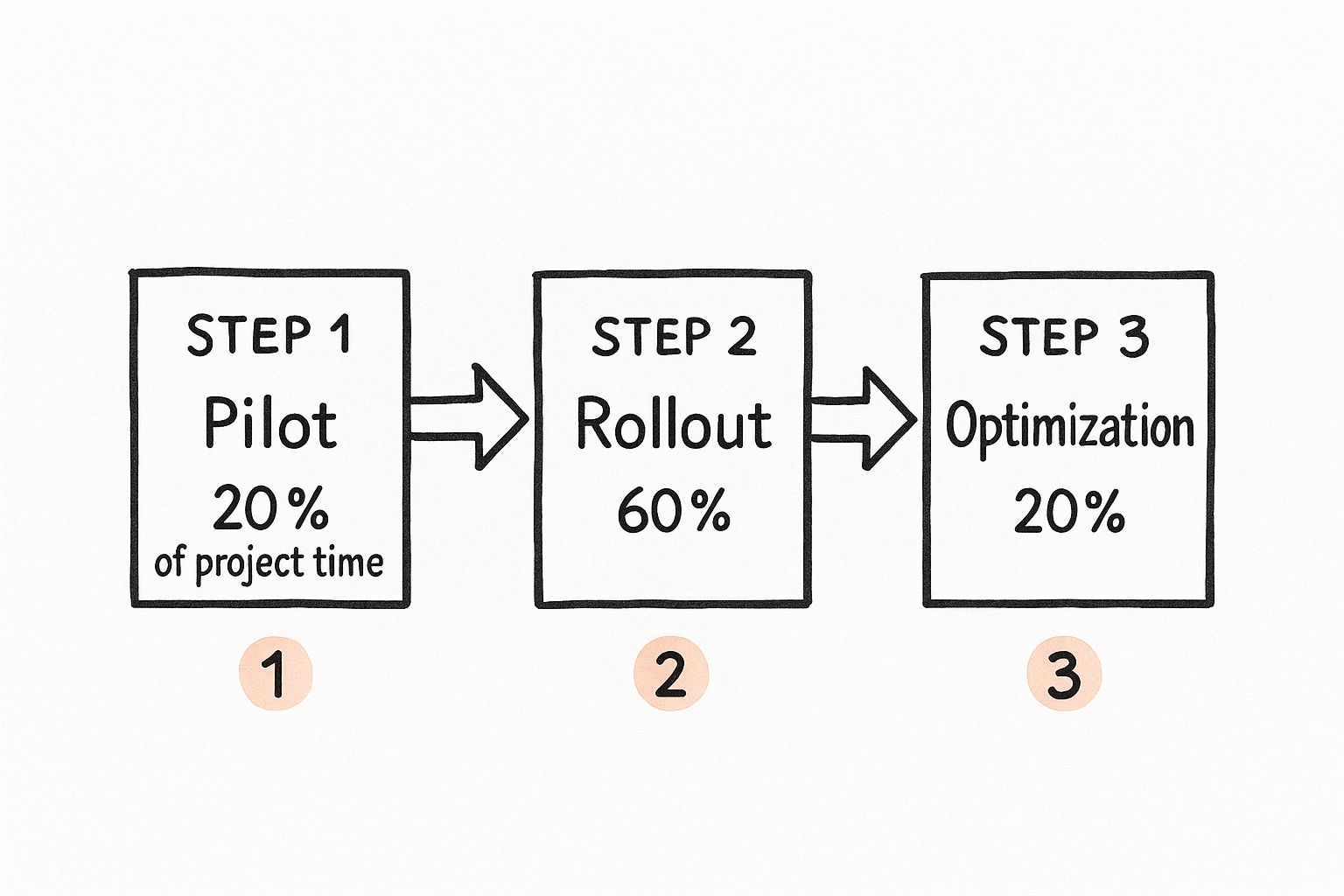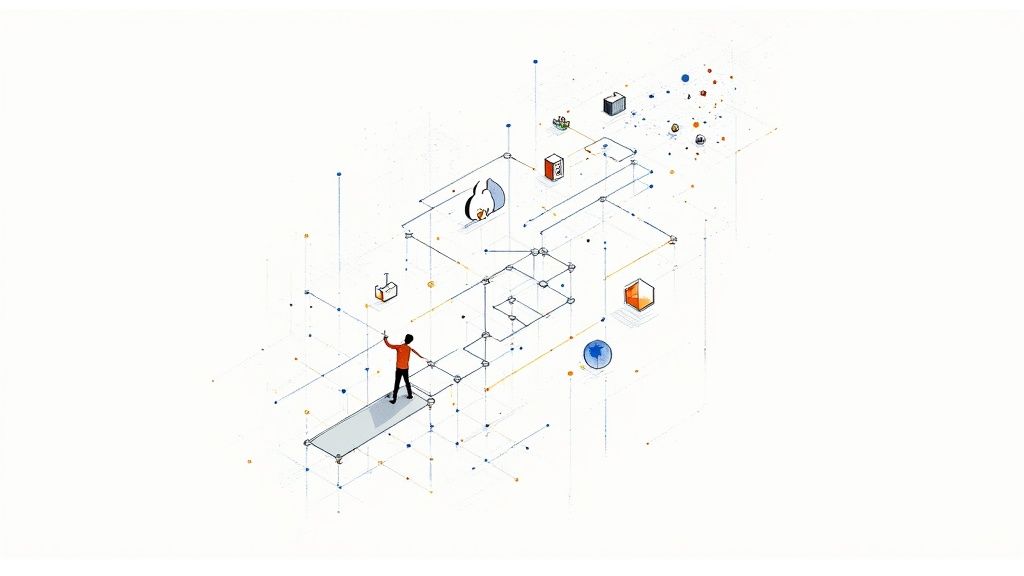Summary:
A digital transformation roadmap is a strategic plan that guides an organization through evolving its operations, culture, and customer experiences, aligning technology investments with business goals. Many initiatives fail due to a disconnect between vision and execution, employee resistance, and lack of change management. Successful roadmaps require clear communication, stakeholder engagement, and addressing human and cultural aspects alongside technology. By prioritizing initiatives, assigning ownership, and integrating measurable KPIs, organizations can effectively implement and adapt their transformation strategies, ensuring alignment with long-term objectives while remaining agile to market changes.
Table of Contents
A digital transformation roadmap isn't just a list of tech upgrades. Think of it as a strategic plan that details, step-by-step, how your organization will actually evolve its operations, culture, and customer experiences to stay relevant. It’s the essential bridge connecting your technology investments to real, measurable business goals.
Why So Many Digital Transformations Stall
Let's be honest: most digital transformation initiatives never reach their full potential. It’s a tough reality, but understanding why is the first step toward making sure yours is different. This isn't just about a botched software rollout; it's usually a fundamental breakdown in vision, alignment, and culture.
The numbers paint a pretty grim picture. Roughly 70% of digital transformation projects fail to meet their objectives, and only about 40% of organizations ever manage to scale their efforts successfully. A massive piece of this puzzle is the human element-a staggering 70% of initiatives get bogged down by employee resistance and cultural pushback.
This high failure rate isn't inevitable, though. It’s a symptom of a few common, yet powerful, issues that a well-crafted roadmap can and should address head-on.
The Disconnect Between Vision and Execution
One of the biggest culprits I see is the gaping chasm between the C-suite's grand vision and the daily reality for the teams on the ground. A leader might announce a bold new direction, but without a clear, communicated plan, that vision remains a vague, abstract idea.
A roadmap’s real job is to translate an ambitious goal into a series of connected, achievable steps. Without that bridge, teams are left trying to interpret fuzzy directives, which leads directly to misaligned priorities and wasted effort.
For a roadmap to have any teeth, it has to answer the "what's in it for me?" question for every single person and department involved.
Ignoring the Cultural Bedrock
I've said it before, and I'll say it again: technology is only an enabler. Real change happens when people adjust how they work, think, and collaborate. Too many roadmaps fall flat because they're treated like pure IT project plans, completely overlooking the critical need for change management.
- Employee Resistance: Change breeds uncertainty. If your team doesn't get the "why" behind a new tool or process, or if they fear their jobs are on the line, they'll naturally dig their heels in.
- Lack of Real Sponsorship: Genuine executive sponsorship is more than just signing checks. It means having leaders who are visible champions of the change, actively removing roadblocks, and constantly reinforcing the vision.
- Skill Gaps: Rolling out advanced analytics or AI is pointless if your teams can't use them. A solid roadmap must account for training, upskilling, and professional development.
Effectively navigating this shift requires strong leadership. To better prepare for these human-centric challenges, you can explore our guide on the vital role of leadership in change management.
To help you get ahead of these common pitfalls, I've put together a quick-reference table. Think of it as a cheat sheet for building a more resilient roadmap from the start.
Common Digital Transformation Failure Points and Solutions
| Failure Point | Underlying Cause | Roadmap Solution |
|---|---|---|
| Lack of Clear Vision | The "why" is not communicated or understood across the organization. | Start with a clear, compelling vision statement. Define what success looks like in concrete business terms, not just technical milestones. |
| Employee Resistance | Fear of the unknown, job insecurity, or lack of involvement in the process. | Integrate a comprehensive change management plan. Involve employees early, communicate transparently, and create feedback loops. |
| Poor Executive Sponsorship | Leadership is not actively or visibly championing the initiative. | Secure a dedicated executive sponsor who will remove obstacles, communicate progress, and hold teams accountable. |
| Siloed Execution | Departments work in isolation, leading to fragmented efforts and incompatible tech. | Create cross-functional teams from day one. Ensure the roadmap is a shared document that aligns all departmental goals. |
| Ignoring Skill Gaps | Teams are expected to use new tools without proper training or support. | Include a dedicated workstream for upskilling and training. Conduct a skills gap analysis and budget for necessary education. |
| No Quick Wins | The project is too long-term, causing a loss of momentum and stakeholder buy-in. | Structure the roadmap to deliver tangible, small wins early and often. This builds confidence and demonstrates value quickly. |
Confronting these failure points head-on is the only way to design a digital transformation roadmap that's not just ambitious, but also practical and resilient enough to actually succeed.
Uniting Your Team Around a Shared Vision
A great digital transformation roadmap isn't really about the technology. It's fueled by a unified, compelling vision that everyone can get behind. This is the part where you stop talking in abstract goals and start painting a clear, shared picture of the future.
Success here means turning your strategic objectives into a story that hits home for every single person in the company.
It all starts with figuring out who your real stakeholders are. Look past the C-suite and the board members for a minute. Your most critical stakeholders are often the department heads, team leads, and frontline managers who will live and breathe these changes every single day. Their buy-in isn’t just nice to have; it’s the fuel you need to get any real momentum.
Crafting a Compelling Narrative
Your vision can't be some dry, corporate mission statement collecting dust on a shelf. It needs to be a story that answers the one question on everyone’s mind: "Why are we even doing this?" A strong vision connects the dots between the work and real, tangible benefits for the company, its customers, and-just as importantly-its employees.
For example, instead of saying, "We will implement a new CRM to improve data hygiene," try something with more punch. A better story is: "We're going to give our sales and support teams a complete, real-time view of every customer. We can stop asking people the same questions over and over and start solving their problems faster than anyone else in our industry." See the difference? You just shifted the focus from a tool to an outcome.
To get this narrative right, pull your key stakeholders into collaborative workshops. These aren't just feel-good brainstorming sessions. They should be structured forums for hashing out what the future actually looks like.
- Define the "From-To" State: Get crystal clear on the shift you want to see. For instance, you're moving from siloed data and reactive decisions to a single source of truth and proactive insights.
- Identify Core Business Drivers: Is this all about grabbing market share? Improving operational efficiency? Or making the customer experience unforgettable? Every piece of your vision has to tie back to one of these drivers.
- Paint a Picture of Success: What does a "win" look like in 18 months? Be specific. Maybe it’s cutting customer service response times by 50% or boosting cross-sell revenue by 20%. Make it measurable.
Building a Coalition of Champions
A vision statement on its own won't change a thing. You need a powerful coalition of internal champions-people who will carry the message and build momentum inside their own teams. These are the influential folks who others look to for guidance, and their job title doesn't always tell the whole story.
Your goal is to find the well-respected skeptics and the natural early adopters. Winning over the skeptics provides powerful social proof, while empowering the adopters gives you a volunteer army to help others navigate the change.
Once you’ve identified these people, get them involved in the planning process early. Give them a real sense of ownership over parts of the roadmap. When they feel like co-creators of the plan, they become its most passionate advocates. This is how you build a culture of shared responsibility, not top-down directives.
To make this work, leaders have to be relentlessly open. Trust is built on transparency, especially during big changes. You can learn more about how to empower your teams through transparent leadership in our detailed guide on the topic.
Communicating the Vision Effectively
With your story and your champions ready, the final piece is a relentless communication plan. Seriously, you cannot over-communicate the vision. Different people need to hear the message in different ways, framed around what matters most to them.
Communication Channel Plan
| Audience | Key Message | Best Channel |
|---|---|---|
| Executive Leadership | How the roadmap hits financial goals and secures our market position. | Board meetings, monthly business reviews, detailed reports. |
| Middle Management | How these changes help them crush their department's targets and make their teams more effective. | Departmental meetings, dedicated workshops, one-on-one check-ins. |
| Frontline Employees | What’s in it for them-how new tools cut out tedious work, make their day smoother, and help them win. | All-hands meetings, team huddles, internal newsletters, video demos. |
This multi-channel approach makes sure the vision isn't just a poster on the wall. It becomes a living, breathing part of the organization's daily conversation. By uniting your team around this shared picture of the future, you build the resilient foundation your digital transformation roadmap needs to actually succeed.
Mapping Your Current Digital Landscape

Before you can chart a course to where you're going, you have to know where you are. It sounds obvious, but it’s a step I’ve seen teams skip over and over again, only to pay for it later. This is the stage where you get brutally honest about your organization’s current reality.
Forget assumptions. The goal here is a clear, data-driven snapshot of your technology, processes, and people. It's a deep dive that forms the foundation for every decision that comes next.
Auditing Your Technology and Processes
First, it’s time for a hard look at your tech stack and the workflows built around it. In many organizations, this reveals a patchwork of legacy systems, homegrown tools, and disconnected cloud services that have been cobbled together over years. Your audit needs to be unflinching.
Start by listing the core systems that run the business-your CRM, ERP, development pipelines, data warehouses, the whole lot. Then, for each one, ask some tough questions:
- Is it still fit for purpose? Or are teams duct-taping it with manual workarounds just to get by?
- Is it a bottleneck? Is this system the reason you can’t launch features faster or integrate with modern tools?
- What's the real cost? Go beyond the license fees. Factor in maintenance hours, downtime, and the opportunity cost of being stuck.
At the same time, you need to map out the critical business processes that depend on this tech. Documenting how information flows (or gets stuck) between departments is often where the real horror stories emerge. You might discover sales and support use separate CRMs, forcing manual data entry and creating a fractured customer experience. It happens more than you’d think.
A thorough audit reveals the friction points in your organization. These are the areas where a small, targeted investment can deliver an outsized return by removing a persistent bottleneck for multiple teams.
This process gives you tangible problems to solve. You stop saying vague things like "we need to improve efficiency" and start identifying specifics like, "our manual order entry takes 15 steps and has a 10% error rate." Now that's a problem you can sink your teeth into.
Assessing Your People and Skills
Here's a hard truth: a digital transformation is driven by people, not by software. Your tech audit is only half the picture without an equally honest look at your team's skills. It’s useless to roll out sophisticated AI analytics if nobody knows how to ask the right questions or interpret the results.
This isn't just about your IT department; it’s about everyone. You need to gauge digital literacy across the entire organization.
- Technical Teams: Do your engineers have hands-on experience with modern cloud architectures and the APIs you plan to integrate?
- Business Teams: Are your marketing and sales folks comfortable using data to drive decisions, or are they still running on gut instinct?
- Leadership: Do your managers have what it takes to lead data-driven teams and foster a culture of experimentation?
Running a formal skills gap analysis gives you the hard data you need to build training and upskilling programs directly into your roadmap. It’s far more effective to plan for this now than to scramble to hire your way out of a skills deficit down the road.
Identifying High-Impact Opportunities
Once you have a clear picture of your current state-your tech, processes, and people-you can start spotting the real opportunities. The trick is to prioritize initiatives that offer the best balance of impact and feasibility.
A classic mistake is to chase the latest shiny object instead of fixing foundational problems. To sidestep that trap, I like to categorize potential initiatives into a simple framework.
Opportunity Prioritization Framework
| Category | Description | Example |
|---|---|---|
| Quick Wins | Low-effort, high-impact projects that build momentum and solve immediate frustrations. | Automating a repetitive manual report that saves a team 10 hours per week. |
| Foundational Projects | Larger initiatives that fix core infrastructure or process issues, enabling future innovation. | Migrating a legacy customer database to a modern, cloud-based CRM. |
| Strategic Bets | High-effort, high-potential projects that could create a new competitive advantage. | Developing a predictive analytics model to reduce customer churn. |
My advice? Tackle a few quick wins first. They show immediate value and get stakeholders excited. While those are in motion, start planning the bigger foundational projects that will unlock the most significant gains. This balanced approach keeps your roadmap grounded, delivering both quick relief and long-term strategic value.
Architecting Your Actionable Roadmap
With your vision set and a clear picture of where you stand today, it's time to build the engine for your transformation. This is where the big-picture strategy gets translated into a concrete, step-by-step plan that connects your goals to the daily work of your teams.
A great digital transformation roadmap isn't some static document you file away. It's a living guide that has to balance long-term ambition with the short-term realities on the ground. It brings clarity, aligns your resources, and ensures every single initiative-big or small-is pushing the company in the right direction. The trick is to break the whole journey into logical, manageable chunks.
Sequencing Your Initiatives for Maximum Impact
Let's be honest: not all projects are created equal. Trying to tackle everything at once is a surefire recipe for burnout and failure. The most effective roadmaps I've seen sequence their initiatives strategically, often by bucketing them into different horizons or phases. This approach makes sure you fix the foundational cracks before you try to build some complex, innovative skyscraper on a shaky base.
Think of it in three distinct waves:
- Horizon 1: Foundational Fixes. These are the non-negotiable, "must-do" projects that address the immediate pain points you found in your audit. This is often the less glamorous work, like modernizing legacy systems, cleaning up messy data, or automating mind-numbing manual processes. But they deliver immediate value and build a stable platform for everything that comes next.
- Horizon 2: Strategic Enhancements. Once the foundation is solid, you can shift focus to the initiatives that directly fuel your strategic goals. Maybe that's launching a new customer portal, implementing a more powerful CRM, or rolling out data analytics tools to the business teams so they can make smarter decisions.
- Horizon 3: Innovative Leaps. These are your forward-looking "big bets"-the projects with the potential to genuinely disrupt your market. We're talking about AI-driven personalization, predictive maintenance, or entirely new digital business models. These are only really possible once the first two horizons are well underway.
This tiered approach creates a natural momentum, where each phase enables the next. It also helps manage stakeholder expectations by delivering consistent value over time, instead of asking for years of investment before anyone sees a single result. As you're putting this together, having a solid framework for strategic planning for digital initiatives is essential to keep everything on track.
From Timelines to Ownership
A plan without timelines and owners is just a wish list. Every single initiative on your roadmap needs crystal-clear accountability. This is what prevents critical projects from getting stuck in that no-man's-land between departments.
Every initiative should have:
- A Single, Designated Owner: This is the person responsible for driving the project forward, securing resources, and reporting on progress. It’s not a committee-it's one individual who is ultimately on the hook.
- A Cross-Functional Team: The owner needs support from a team with people from all the affected departments (think IT, marketing, sales, operations). This ensures every perspective is heard and helps build buy-in from the start.
- Realistic Timelines with Milestones: Break down huge projects into smaller, trackable milestones. Instead of a vague 12-month deadline, set quarterly goals to keep momentum high and give yourself room to course-correct.
These are the same principles that apply when you create a product roadmap, where clear ownership and phased rollouts are absolutely critical for success. The logic is identical: break down the complexity to make progress manageable and, most importantly, visible.
A common mistake I see all the time is assigning ownership to a department instead of a person. "IT will handle it" is not an ownership plan. "Maria from Engineering is the project lead" is. That simple shift dramatically increases the odds of success.
Integrating KPIs to Measure What Matters
Finally, your digital transformation roadmap has to be measurable. How will you know if you're actually winning? By baking Key Performance Indicators (KPIs) directly into the framework from day one. Each initiative must be tied to specific, quantifiable business outcomes.
This is absolutely critical for showing the ROI of your efforts. The global digital transformation market is exploding, with worldwide spending hitting around $2.5 trillion in 2024 and projected to reach $3.9 trillion by 2027. To justify your piece of that investment, you have to prove its value.
The infographic below shows a common framework for phasing project execution and allocating time effectively across pilot, rollout, and optimization stages.

This visual really highlights a balanced approach where the bulk of the effort goes into the main rollout, but you've still reserved critical time for initial testing and post-launch refinement. When you structure your roadmap with these clear phases, defined ownership, and embedded KPIs, you turn a strategic document into a powerful engine for getting things done.
Bringing Your Roadmap to Life: Execution and Adaptation

A digital transformation roadmap isn't some artifact you frame and hang on the wall. Its real value comes to life when it becomes a living, breathing guide for your entire organization. This is where the rubber meets the road-where your careful planning turns into real business momentum.
The best roadmaps are built to be fluid. They assume markets will shift, customer needs will change, and new tech will pop up. Success in this phase comes down to how well you manage the rollout, govern changes, and adapt without losing sight of your North Star.
Build a Foundation of Governance and Communication
Once you start executing, clear governance becomes your best friend. Without it, a roadmap quickly dissolves into chaos, with different teams pulling in opposite directions. Your first move should be to set up a cross-functional steering committee. Think of it not as a bureaucratic roadblock, but as a nimble decision-making group.
This team’s main job is to protect the roadmap's strategic goals while giving teams the freedom to make smart adjustments.
Their responsibilities should look something like this:
- Keep a Pulse on Progress: Hold monthly or quarterly reviews to track how you're doing against your KPIs.
- Clear the Path: Act as the go-to group when teams hit obstacles that span across departments.
- Vet Scope Changes: Evaluate any new requests or pivots against the original business case. Is it a distraction or a genuine opportunity?
- Champion the Wins: Make sure that successes, both big and small, are celebrated and shared across the company.
That last point is more important than you think for keeping morale and momentum high. When you roll out a new automated reporting tool that saves the finance team 20 hours a month, shout it from the rooftops. It builds confidence and proves the transformation is delivering real value.
A common mistake is treating the roadmap launch as the finish line. It’s actually the starting gun. Consistent communication and active governance are what get you through the marathon of execution.
Embrace Agility with Tight Feedback Loops
Think of your roadmap as a hypothesis. The execution phase is where you test that hypothesis against the messy reality of the market. This means you need to build feedback loops directly into your process to catch real-time data and insights.
Let's say a software company rolls out a new customer portal. The goal is a 15% increase in self-service ticket resolution. A month in, they see that while plenty of people are using it, resolution rates haven't budged. This isn't a failure; it's a critical piece of feedback.
The feedback loop-a mix of usage analytics and a few quick customer surveys-reveals that the portal’s knowledge base is a pain to navigate. Armed with this insight, the team can pivot. Instead of blindly pushing forward, they can tweak the next sprint to focus on improving the search function. It’s a small change that directly addresses the feedback and gets them closer to the actual business outcome.
Measure What Matters Using Live Dashboards
To make those kinds of agile moves, your team needs information, and they need it now. This is where live performance dashboards become essential. These aren't just for executives; they should visualize the KPIs you defined earlier, turning a sea of data into a clear story of your progress.
A solid dashboard for a digital transformation roadmap usually tracks a mix of metrics:
| Metric Category | Example KPI | Its Purpose |
|---|---|---|
| Adoption Metrics | Daily Active Users (DAU) of a new tool | Are people actually using the tech you rolled out? |
| Operational Metrics | Average ticket resolution time | Is it making your processes faster or more efficient? |
| Business Metrics | Customer Lifetime Value (CLV) | Is this work actually moving the needle on revenue? |
This constant flow of data allows you to adapt intelligently. After all, the market isn't waiting for you. Research predicts the digital transformation market will jump from $1.75 trillion in 2024 to over $2.1 trillion in 2025, driven by advances in AI, IoT, and the cloud. You can learn more about these key market drivers and what they mean for your strategy.
This kind of adaptability ensures your roadmap doesn't just deliver a one-off project. It builds a lasting culture of continuous improvement.
A Few Common Questions About Digital Transformation Roadmaps
As you get your hands dirty and move from high-level planning to the day-to-day work of execution, questions are going to pop up. This isn't a sign that your plan is weak; it's a sign that your team is actually engaged and thinking through the details.
Here are a few of the most common questions I hear from leaders building and managing their own digital transformation roadmaps, along with some straight answers based on what I’ve seen work.
How Long Should Our Digital Transformation Roadmap Be?
There’s no magic number here, but the best approach I've seen is a balanced one. You need a strategic vision that looks out 3 to 5 years. This is your North Star. It’s what you use to get the entire company aligned on the big picture and, just as importantly, to secure the budget for those major, long-term goals.
But when it comes to the actionable part of your plan, you need to zoom in. Way in. Focus on a detailed, granular plan for the next 12 to 18 months. This shorter timeframe keeps you honest about what’s actually achievable and gives you the agility to react when things change. And they always change.
Think of it like this: your 5-year vision is the destination city, but your 12-month plan is the turn-by-turn navigation for the first leg of the journey. It’s detailed, specific, and can be adjusted if you hit a detour.
For the later years of the roadmap, you can keep things at a higher level-outlining broad objectives rather than specific projects. This gives you that perfect blend of a stable long-term direction with the flexibility to adapt to new opportunities or market feedback.
Who Should Own the Digital Transformation Roadmap?
It’s tempting to hand this off to one executive, like the Chief Digital Officer or CIO, and call it a day. But in my experience, that’s a mistake. True ownership has to be a shared responsibility.
Yes, you absolutely need a single executive sponsor for accountability. This is the person who ultimately answers for the roadmap’s success. But the stewardship-the day-to-day decisions and guidance-needs to be a team sport.
The most effective model I’ve seen is a dedicated cross-functional steering committee. This group becomes the guardians of the roadmap.
- Who’s on it? This is non-negotiable: you need leaders from IT, operations, product, marketing, finance, and HR. Every key function needs a seat at the table.
- What’s their job? They review progress, clear roadblocks that pop up between teams, and give the green light on any major pivots to the plan.
- Why does it work? This setup ensures every part of the business has a voice and, more importantly, skin in the game. It demolishes silos and shifts the perception from "an IT project" to a unified, company-wide mission.
This kind of collective ownership is what builds the resilience you need to see a complex, multi-year transformation through to the finish line.
What Is the Biggest Mistake to Avoid?
I’ve seen this one sink more initiatives than I can count: creating a roadmap that’s all about technology and completely ignores the people and processes. A brilliant tech strategy will fail, spectacularly, if it doesn't account for the human side of change.
A roadmap that's just a list of software to implement or systems to migrate isn't a transformation plan. It's an IT project list. A real digital transformation roadmap has to weave together three core pillars:
- People: Who needs new training? How will job roles evolve? What's your communication plan to bring everyone along for the ride, not drag them kicking and screaming?
- Process: Which workflows need a complete redesign before you even think about new tools? How will you streamline operations to actually capitalize on the new tech?
- Technology: What are the specific platforms, tools, and infrastructure required to make the people and process changes possible?
If your plan doesn't seriously address the first two pillars, you’re setting yourself up for fierce internal resistance and a failure to deliver on the promised value. It's almost guaranteed.
How Do We Measure the Success of Our Roadmap?
Success is about more than just checking boxes and declaring a project "done." You need a balanced scorecard of metrics that clearly connects your tech investments to real, tangible business outcomes. A solid measurement framework will track success across a few different layers.
Key Measurement Categories
| Category | Example Metrics | What It Tells You |
|---|---|---|
| Technology KPIs | System uptime, user adoption rates, API response times. | Is the new tech working reliably and are people actually using it? |
| Operational KPIs | Cycle time reduction, cost per transaction, process error rates. | Are we becoming more efficient and effective in how we do our work? |
| Business KPIs | Customer satisfaction (CSAT), revenue growth, market share. | Is this transformation actually delivering on its ultimate promise to the business? |
By tracking this mix of metrics, you can tell the full story of the value your digital transformation roadmap is creating. It lets you celebrate the technical wins, show concrete operational improvements, and ultimately prove the impact on the bottom line.
Ready to move beyond theory and build a leadership style that drives real results? At Matthew Mamet, I provide specialized coaching that empowers software executives to build high-performing teams and execute winning strategies. Let’s connect and create your playbook for tangible growth at https://matthewmamet.com.
Ready to drive more growth & achieve bigger impact?
Leverage my 25+ years of successes and failures to unlock your growth and achieve results you never thought possible.
Get Started



